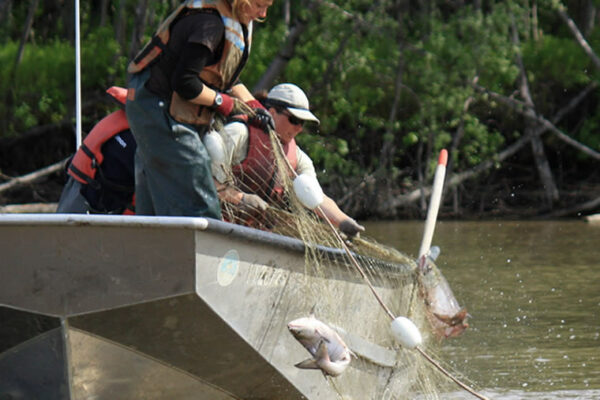
Despite hours of testimony from residents of the Yukon and Kuskokwim rivers who called for urgent action to curb the salmon bycatch by Bering Sea trawlers, the North Pacific Fishery Management Council decided to approach the problem more methodically.
In a unanimous vote near the end of its five-day meeting in Sitka, the Council recommended further study of salmon declines in the Bering Sea, and a closer look at their connection to climate change.
Salmon abundance in the Yukon River, the third-largest river in North America, has dropped sharply in the past two years.
The forecast is no better this season.
Many Yukon and Kuskokwim River residents voiced concern during last Monday’s call.
“At this point, there should be alarm bells going off all over not only in our communities, but all over the state and federal government agencies,” said Vivian Korthuis, the chief executive officer for the Association of Village Council Presidents, a consortium of 56 federally-recognized tribes on the Yukon-Kuskokwim Delta.
Among the region’s 27,000 residents, Korthius said 98% of households harvested salmon. Council meetings typically involve hours of presentations on the scientific research into stock decline, but Korthius pointed out a glaring oversight.
“What your reports don’t show are the families in western Alaska who are worrying about putting fish away to feed their children throughout the winter,” she said. “And parents and grandparents who are unable to pass our way of life down to our children and future grandchildren.”
The salmon collapse is nearly as dire on the Kuskokwim River.
“I normally put away 2,000 chum salmon to feed my dog team,” Mike Williams, Sr., of Akiak testified, “Last year I caught only two chums.”
Williams chairs the Kuskokwim River Intertribal Commission, which represents 33 tribes in the Kuskokwim River drainage. Williams was discouraged that the pollock trawlers fleet – so far this year – had already caught and discarded 5,100 chinook salmon, and last year caught and discarded 540,000 chum.
He said, “The waste of a single fish is unjust for Iindigenous fishermen,” but recognized that the problem was complex.
“We understand that not every salmon caught by pollock fisheries is bound for Western Alaska. We understand that other factors like climate change, and competition with hatchery fish have impacts on our salmon in their marine environment. But we know that this council has the power to enact regulations, and plans to reduce salmon bycatch,” he said.
37 people signed up to testify before the council on the issue, most of them urging the council to reduce the amount of allowable bycatch of chinook and chum salmon by the pollock fleet. But it was clear from reports about conditions in the Bering Sea, that although the bycatch numbers are significant, they’re still a fraction of the overall decline in salmon.
Stephanie Madsen, the director of the At-Sea Processors Association, sympathized with the crisis faced by the villagers of Western Alaska. But she suggested that it was a mistake to pin the blame on trawlers, if at all.
“I understand from public testimony and reality that it really is at this time, the only thing that is controllable,” she said. But she said there were other factors, like climate change and lack of food.
Madsen argued that the decline in salmon was a coast-wide issue, and that if the Council took steps to reduce the incidental catch of salmon by trawlers, and the results were “not what folks are hoping for, disappointment will continue.”
The effort to play down the significance of trawl bycatch did not sit well with representatives of other fishing industry sectors who testified on the issue.
Sitka resident, and former Council member, Linda Behnken the executive director of the Alaska Longline Fishermen’s Association said it was the Council’s responsibility to address the disproportionate impact of the salmon collapse.
“Clearly, the way we’re inhabiting this planet is unsustainable, that people have the AYP minimally participate in that unsustainable culture, but they’re bearing the brunt right now of those impacts in Alaska,” she said.
Behnken was a key figure in working to ban trawling off the coast of Southeast Alaska. She didn’t believe that trawling – although an important provider of protein to the world – was in any way sustainable, even when Council member Anne Vanderhoeven, who works for the Seattle-based Arctic Storm Management Group, argued that trawling had a lower carbon footprint, according to a peer-reviewed study released last year commissioned by an industry group.
Behnken’s pointed out that the failure of salmon runs also affects the culture of the area.
Given the intensity of the feelings around bycatch, the motion brought forward by the Council’s Advisory Panel was tepid. Advocates hoped to see the allowable bycatch of chinook cut from 45,000 to 16,000. They also wanted the bycatch of chum halved from 500,000 to 250,000. Instead, they got an extensive document that boiled down to a commitment to minimize bycatch.
There was also a call for further research to tease out whether lowering the current caps on the trawl bycatch of chinook and chum would make any difference at all to the recovery of the stocks in Western Alaska.
The motion included language to incorporate more traditional knowledge into the decision-making process in the future.
Robert Woolsey is the news director at KCAW in Sitka.




